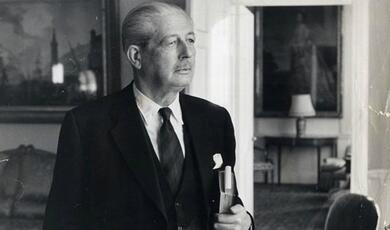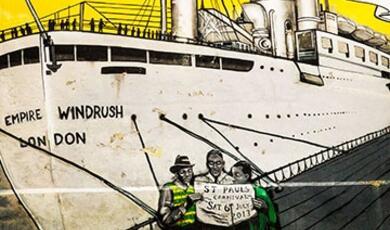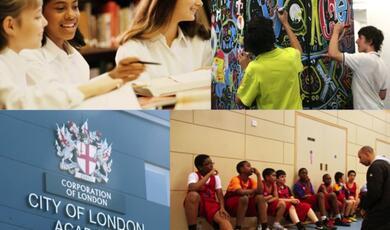The City Livery Companies
Share
- Details
- Transcript
- Audio
- Downloads
- Extra Reading
Trade and craft associations have flourished all over Europe for many centuries, but the City of London companies, now collectively known as the Livery, are unique in their survival, number and diversity. The social and economic conditions which gave birth to the original guilds have long since been overtaken by the development of industry and commerce, but the livery companies still flourish today as living institutions. Their survival has been achieved by doing what they have always done: fostering their trade in a wide context, serving the community, and embracing modern skills and professions.
This lecture is part of the Square Mile series. The other lecture in the series is The History of the Lord Mayor's Show.
Download Transcript
07 December 2011
The City Livery Companies
Professor Tim Connell
Initial reflections [PIC1] It might be fair to say that if the livery companies did not exist, then there is little chance that anyone would invent them today. Over the centuries they have nearly faded out of existence of their own accord, as the City and its trades have changed; they have been threatened by successive governments; they have been persuaded by unscrupulous penny-pinching monarchs to buy their own charters back again. [PIC2] They have been dismissed as dining clubs for the privileged, bastions of reactionism, anachronisms which are both archaic and obscure. Yet how does this explain the steady addition of new companies in the last decade, ranging from the World Traders to the Agricultural Journalists (that I only heard about at the United Guilds Service earlier this year)? Perhaps this is because they have found new ways of interpreting traditional interests (like the Horners and their support for the plastics industry), or who reflect modern trades, such as the Tax Advisers, not to mention the Hackney Cab Drivers and the Security Professionals.[i] And the people who join them, the ones who run them and even those who support them from afar, clearly see benefits in belonging.
So the livery companies are not so much a City feature as a City survival; they seem to be flourishing today and have managed to re-invent themselves more than once in the past. They remain a fascinating aspect of public life in the City of London, though (as we shall see) they are not actually unique either in the UK or abroad. But nowhere is there such a concentration, nor can there be any set of private organisations which contribute so much to public life. They play an important role in matters of governance in the Square Mile; they have a high profile in all sorts of charitable activities, ranging from alms houses and education to support for different units of the Armed Forces; and a number of them still have a direct role to play in the management, training or maintenance of standards in their own particular trade. The forty-three surviving halls are magnificent venues for a wide range of events. Most are masterpieces in their own right, though forty-four were lost in the Great Fire, and thirty in the Blitz, whilst others were lost in other fires at different times. Some companies, such as the Carpenters, the Glaziers or the Salters, have quite deliberately gone for a more modern or contemporary style. But every hall has its own particular features and treasures; many are used for outside events and are very much a feature of life in the Square Mile.[ii] However, other cities had guilds of their own, some of which survive to this day in places like Chester, Newcastle and Dundee.[iii] A shoemaker in Canterbury, one John Marlowe, was made free of the city in 1564 and his son Christopher then went to King’s School and from there to Corpus Christi College in Cambridge, so members of guilds were of some social standing. [iv] [PIC3] Some City guilds (like the Bakers) maintain links with some of those continental cities that continue to have guilds which also seem to replicate the blend of training, charity and good dining that characterise a proper livery company. Berne, Cologne, Dusseldorf and Zurich have all maintained the tradition. Spain has its hermandades and cofradías linked, like the mediaeval guilds, to a particular church; Seville is by no means the only city in Spain to have those amazing Easter processions. Over in the New World Buenos Aires has its own guilds for professions and crafts, including Los Martilleros, the Hammermen, which goes beyond Glasgow's guild to include anyone who works with a hammer - including auctioneers.
London does appear to be unique in the relationship that exists between the livery companies and local government in the form of the Corporation of the City of London, but then if you go back far enough, the guilds and liveries were indispensable to almost every aspect of life in the capital. The whole concept of trade guilds is, I think, well known and understood. They have their roots in Saxon times (a fair number of livery companies believe that they go back that far in almost unbroken lineage) and acted as friendly societies, helping people in bad times, contributing to the care of orphans and acting as a burial society, hence the extensive links that companies have to this day with City churches. Their role as a supervisory body for their particular craft is also easily understood: they were responsible in today’s terms for professional training, quality control and external relations. They supervised the quality of the craftsmen’s products, and applied hefty sanctions to those who failed to meet the necessary standards through neglect or dishonesty, hence the modern-day term the Baker’s Dozen.[v] They oversaw training through the system of apprenticeships, hence our word “masterpiece” which the apprentice had to show in order to be made free of his company. [PIC4] I say “his” but there is evidence to suggest that women were sisters or freemaidens of companies from an early date and in the 14th Century only five of around five hundred guilds excluded women, though they were not involved in matters of governance.[vi] In fact widows held a particular economic position in later times because they had inherited the assets and business of their late husband. There are few women in livery history, however, to match the devotion to her company of the redoubtable Elizabeth Pickering Jackson Redman Cholmeley – who in the 1530s and 40’s married no fewer than three Stationers (though not at the same time) and who became a successful printer in her own right.[vii]
Tudor times and Beyond [PIC5] Critical to London in the Sixteenth Century, and hence the fortune of the livery companies, is population growth. In 1509 the City and its few outlying areas, numbered about 50,000 people. This had grown by the time of Elizabeth’s accession in 1558 to 90,000 and by the time of her death in 1603 London had reached a quarter of a million. Many people had been dispossessed by enclosures, there was the constant phenomenon of vagabonds and the sturdy beggar; and increasingly there was a flow of religious refugees from the Lowlands and France, many of whom brought quite specific skills, such as silk weaving or glassmaking.
This growth meant that the City itself was bursting at the seams, and the population naturally spilt over into country areas such as Chelsea (where Sir Thomas More had his country home and orchard) and over the river into Southwark. This in turn challenged the livery companies’ traditional role in both the control and supervision of their trades, and the matter of local government. There was also the major issue of combating what was seen as unfair foreign competition, led by the influx of foreign tradesmen, many of whom brought new skills with them.
Ultimately it was recognised that it was just not possible to be at the centre of trade and markets if regulations were too restrictive (always supposing that they were enforceable) and that this could have the equal and opposite effect of limiting our own trading potential abroad, which was clearly going to be harmful, given the number of companies which had been set up to develop overseas trade links and whose merchants, ships and goods were all too open to retaliation.
During the whole of this period (and even before) the guilds were beginning to change in nature as their membership moved away from being related strictly to the craft in question, and new prosperity created a demand for luxury goods, such as the stained glass which was the preserve of the Glaziers, at a time when glass was so valuable that it would not be listed in a house sale under fixtures and fittings, but as a moveable and transportable item. Membership expanded, especially in the more powerful companies, to include the new commercial elite whilst still offering members the opportunity to move from apprentice to freeman to householder and small businessman with a stake in the management of the City.[viii] Some livery companies continued to maintain tight control over their particular trade.
It was probably the situation with the Low Countries that led the City to look further afield for commercial ventures, and of course the Reformation had provided a new commercial class with capital via the dissolution of the monasteries and the re-apportionment of land as well as property. The Protestant revolt in the Netherlands of 1568 and the position with the Huguenots in France made the whole area increasingly untenable for stable trade. Tudor London therefore became a focal point for Northern Europe, having been little more in economic terms than an offshoot of Antwerp and a minor Hanseatic city. [PIC6] Antwerp itself was sacked by Spanish troops in 1576, an episode known as the Spanish Fury. By 1580 Elizabeth I was sending troops to the Low Countries, so Sir Thomas Gresham was quite prescient in his realisation that Antwerp was finished as a commercial centre, and the opening of his Exchange in 1566 came at just the right time.[ix] We may safely assume that this was not a coincidence. [PIC7]
Sir John Hawkins and his father had begun trading missions (as well as English involvement in the slave trade) via their voyages to Guinea, and these were so profitable that they drew support from senior City merchants, such as Sir Lionel Duckett (Lord Mayor in 1572 and a Mercer – his portrait hangs in Mercers Hall today).[x] [PIC8] The Guinea Company made a range of voyages from 1558 to 1567, paving the way for the Black Triangle of later centuries, whereby manufactured goods went from England to Africa for barter, the slaves were taken across the Atlantic to work on the plantations, whose produce (sugar and cotton especially) then went into the further production and export of manufactured goods.[xi]
Other expeditions tried to find routes through the North West Passage or ways to Persia. Trade to southern Spain and the Canaries was actually quite well established (not least for the importation of sherry and citrus fruits) and English ships went up the Mediterranean coast of Spain as far as Valencia and the Balearics. The Levant Company was set up to trade further East; the Virginia Company went on from trade to colonisation, with very mixed results, as was the case with the first Irish settlements in Munster; the Muscovy Company developed a monopoly on trade with Russia, and the East India Company received its first charter in 1600. All this international expansion provided the livery companies and their members with ample opportunities for investment and (when successful) massive profits.
Ironically perhaps, greater trade opportunities led to increasing friction with the Crown and population growth meant that London itself was changing. The livery companies did have the opportunity to expand beyond the city walls, but this opportunity was lost with the Great Refusal of the 1630s, when the City opted not to take on the government of a rapidly expanding London, and one which was viewed with some suspicion and dislike. The Civil War and Great Fire altered things considerably, so the Square Mile itself never regained its former pre-eminence.
[PIC9] Many Companies went through periods of varying fortunes. They were seen as an easy source of income by James I; most of their silver got melted down to pay Cromwell’s soldiers; and Charles II thought up ingenious ways of persuading the livery companies to fill the gaps in his budget, echoing the actions of Edward III three hundred years earlier, whereby he granted charters in order to raise money for the wars with France.[xii] [PIC 10] The Great Fire deprived forty-four companies of their halls, some permanently. Many companies lost any pretence to being craft guilds as their trades died out, and some became little more than exclusive dining clubs.[xiii]
It was the pressures exerted on them by the attempts at reform in the Nineteenth Century that led to the emergence of the livery companies as we see them today, convivial, supporting a wide range of charitable activities and at the core of public life in the City. Again, it was a mismatch between the growth of London in terms of population, size and industrial activity and the inability or unwillingness of the companies to move with the times – or even fifty years behind them. Further conflict was inevitable: the Royal Commission of 1835, the corporation reforms of the 1850s, and the inquiry which ran from 1880 to 1884 as part of the creation of the London County Council could have led to the dismantling of the City Corporation and even the disappearance of the entire livery concept.[xiv] The “Great Awakening” of the 1870s was a belated but highly effective response to the need for change. Although some companies did go under completely, and others were effectively re-constituted, the livery companies emerged in a form that we would recognise today.
Education and Training
[PIC11] A prime example of this sea change[xv] in the work of the livery is City and Guilds. Sixteen companies clubbed together to form the City and Guilds Institute with the Corporation of London in 1878. The figures today are stunning: it offers five hundred qualifications in twenty-eight subjects; there are two million learners and 1.9 million certificates are issued worldwide, as it now operates in one hundred countries through eight and a half thousand centres, (with major international hubs in Singapore and Johannesburg). [xvi] Not surprisingly, it is at the forefront of distance learning and computer assisted learning methodology.
The Corporation itself is engaged today in numerous activities, ranging from support for half a dozen City Academies through to a whole variety of initiatives related to the employment of the young – reflecting perhaps the traditional function of apprenticeships which formerly started people off on their careers by joining their parent’s livery company through patrimony.[xvii] Most companies sponsor educational organisations, funding famous schools on the one hand and initiatives in the fringe boroughs on the other. Awards, bursaries and scholarships are widespread. Over £14 million pounds a year are given away annually.[xviii]
Some companies (like the Cutlers) still encourage people to enter a particular trade like instrument manufacture, whilst others offer support for particular university departments. The Salters have a particular interest in chemistry and the Clothworkers support textiles and dyeing at the University of Leeds.
[PIC12] The Guildhall published a useful little leaflet last year as part of the 350th anniversary of the foundation of the Royal Society on the amount of support that the livery companies give to Science.[xix] No fewer than 28 companies are identified, which leads me to wonder whether there is scope for encouraging more formal co-operation between sister companies (many of whom, of course, owe their origins in mediaeval times to splitting away from a mother company. The livery has not always been made up of happy families!) A more united front might have more impact with other major charities in the field, which ultimately would be of benefit to the end users. And undoubtedly there are a lot of good news stories that do not get the press coverage they deserve.
Modern perspectives [PIC13 ]An increasing number of people take the Freedom of the City of London, and there is a queue of guilds waiting to take the livery. So what attracts people to a modern-day company? In the words of one distinguished Lord Mayor (actually, thinking about it, all lord mayors are distinguished – even if they are not being given the knighthood they so richly deserve) there are Five Great Points of Fellowship: Charity, Citizenship, Commerce, Comradeship and Conviviality.[xx] These were listed by the celebrated Colonel Blackham, member of three companies, and Clerk of the Glaziers for twenty-five years.
Charity needs no explanation or justification, although the Charity Commission is becoming more demanding and even militant in its interpretation as to what constitutes charitable work, and the number of foundations (let alone flag days) seems to proliferate year by year, even though people’s ability to donate must reduce as private budgets are hit as much as the public purse. The charitable work of the livery companies today is a continuation of the activities that have been carried on since the inception of the guilds as a source of mutual support for people engaged in the same trade. Many companies still administer funds which are part of a bequest going back centuries. Most liverymen will be able to cite with pride some charitable activity or event which is long rooted in the past, but still observed.
Citizenship; The livery is a way of taking an interest in the life and work of the City, and voting for the Sheriffs and Lord Mayor is both a privilege and a duty. The Livery Committee represents the interests of all the companies.[xxi]
Commerce; again, all the companies support trades. These are difficult times for the workers, let alone the workplace; there are pressures on employers too and livery companies can give moral as well as practical support.
Comradeship; no contest. It seems to follow on from that sense of belonging to something which in so many ways is quite unique. And the annual calendar of any company contains such a range of events and activities that there must be something there for everyone. Comradeship may be defined a bit more widely, of course, as it also give us two more C’s, Concern and Charity, which are expressed via the charitable activities that shape the work of any company.
Finally - Conviviality; livery dinners and events are justly celebrated, even if the menu no longer runs to the dozen courses (with wine and liqueurs) that members chomped their way through in Victorian times.[xxii] But there is a serious purpose behind all this junketing, as the social life of the company is an effective way of drawing people together, I would like to think, for higher purposes.
Personally, I would add three more Cs: Collegiate, Church and Corporation, as the companies are very collegiate in style (something to be appreciated in an age of mass higher education); most companies have a link with a particular City church; and apart from voting for both Sheriffs and Lord Mayor, liverymen have all sorts of opportunities to interact with both the Guildhall and Mansion House.
[PIC14] There is a certain element of formality and ceremonial to any livery company, but that respects the traditions that can go back several hundred years, creates a sense of shared identity, and serves to underline the important part played by the livery in the life of the City of London. At the Stationers’ Company we have a nice blend of light-hearted formality when new members are cloathed. At the end of the ceremony everyone troops out past a mediaeval chest, and the Under Warden cries, “Please to remember the widows and orphans”. I know of many organisations where you have to pay to get in. The Stationers’ Company is the only one I know where you have to pay to get out...
Where next?
So if we can move on from the Five Cs (to recap, Charity, Citizenship, Commerce, Comradeship and Conviviality) we may add the Two Qs – Quaint but never too Quirky, plus the Three Es - Eminent, Eclectic, Eccentric to which we might add another E for being really rather English! All of which creates a mix which is the direct consequence of history, but which needs to keep one eye firmly on the future.
For something which may appear to be a throwback to the past, with its odd costumes, quaint customs and strong historic roots, the whole livery movement appears to be in good heart. Revival is not in fact that new - the practice of creating new liveries goes back to 1932, when the Honourable Company of Master Mariners was the first new one to be created for 223 years (before anyone puts their hand up, that was the Fanmakers in 1709).[xxiii] However, it would be most unwise to say that all is well. The reputation of the City has taken a bashing in the last year or two; bankers must rank below highwaymen, pirates and even members of parliament in the unpopularity stakes; large amounts of cash and capital, regardless of what they represent and how well they are being used, will always attract envious eyes. The average age of liverymen increases year by year and membership of organisations is not seen in the same light by the Facebook generation as it is by their elders and betters – few of whom can manage to tweet or twitter, let alone upload apps onto their iPad without assistance from their grandchildren!
Most working people, and those in the City above all, find themselves under increasing pressure at work with lengthy office hours, constant interruptions to home life through the use of mobiles and laptops, and the increasing fear of redundancy, early retirement or unemployment. Many people undoubtedly look forward to a time when they will be able to join a livery company and play a more active role, but that tends to be when family commitments are reducing, or quite possibly when career paths become overgrown, get blocked or begin to lose the attractiveness they once had. And many people appreciate the sense of belonging, and also perhaps feel that being accepted in the first place is an accolade in itself. Which it is.
Serious thought needs to be given to attracting new members even so, possibly as freemen, maybe by reviving yeomen at minimal rates of subscription in their twenties and rising by the decade. And I am convinced that sponsorship or support for the young (by which I probably mean the under-35s) will become absolutely critical given the tectonic movements currently taking place in higher education: there could be prizes, bursaries, outfitting grants for new students, one-off payments for the grandchildren of livery members on graduation. The money will have to come from somewhere – and I can’t but help point out that most of us had a free education, so perhaps we have to start paying for it in retrospect now.
To keep up with the times, to reflect the world we live in, and perhaps also to counteract the stereotypes which still exist in the minds of many people, serious thought must be given to increasing the number of women who join as members, not just as occasional though very welcome guests, or who come along on the grounds that if you can’t beat them then you may as well join them. They should be encouraged to move on to the Court, and to become master in due course.[xxiv] For some companies, this is easier given the gender balance among particular occupations, but there is still a strong element of gentlemen’s clubs in the perception that people have, which though quite possibly no bad thing, is in any case not quite fair.
The livery has a significant role to play in working life through its support of industry, and this should be publicised much more. Linking up to trades, working with companies and training organisations, will all add to the relevance of even the most eclectic of companies. Even if their particular trade passed into history years ago, there are still outlets that can be found. And does this mean that livery companies need to develop the concept of corporate members? They already exist but more could be done not only on the grounds of “relevance” but also as a practical means of finding up-to-date ways of supporting the trades and the people who work in them. We could even look at both ends of the spectrum as unemployment among the young starts to creep up to an eye-watering 25% and stories of having to work to the age of 70 are met with grim amusement by people being laid off before they even reach 60.[xxv] Support for wider initiatives or the work of other organisations that in their turn support industry, employment, training, CPD and even outplacement and early retirement courses, all could have their place, given the far-reaching changes that are going on within the economy and working life.
A lot of is being made at the moment of apprenticeships, which virtually died out in the 1980s. Government funding via the Department for Business, Innovation and Skills is going into the Skills Funding Agency, and organisations such as City and Guilds, the National Apprenticeship Service and ProSkills are also playing their part..[xxvi]
To some extent, all this is a continuation of a role that even Sir Richard Whittington would have recognised. And he would undoubtedly approve of the efforts made by all companies, I think, to support charities such as the traditional almshouses or their more contemporary interpretation in the form of sheltered housing or housing associations, as where to live is becoming as big a question for the young in particular as where to get a job. The other traditional role of a company, supporting some element of the armed forces, has become more prominent with the constant demands on the services. The distressing flow of the badly wounded, not to mention the widows and orphans, are our version of collateral damage and will, we should recognise, be with us for many years to come.
Looking Forward
As far as the Square Mile is concerned, does the livery actually have a role to play in controlling events or does it even have a place in a world centred on electronic exchanges, off-floor trading and international banking regulation? Can a practice such as “My Word is My Bond” work in a global context at a time when half the workers in the Square Mile hail from abroad? At a time when people are thinking about greater external control is there perhaps still space to think, not just in terms of self-regulation which is currently out of fashion, but of an environment where people feel a sense of commitment to the Square Mile and who do think about what is good for it; which provides an opportunity for people to meet on equal social terms and collaborate on a large scale in charitable works for the public good? If such people can have a direct influence on the way in which the Square Mile is governed, then so much the better for everyone. One way or another, there is no doubt that the livery movement will be with us for the foreseeable future – and it is up to us in each generation to ensure that it is relevant, it does serve a purpose and it is in a fit state to pass on to the next generation – for them to make of it in their turn, what they will. In the words of the celebrated livery toast: May they flourish root and branch – for ever and ever and ever. [PIC15]
© Professor Tim Connell, Gresham College 2011
FOOTNOTES
[i] David Palfreyman’s very comprehensive London’s Livery Companies (Oracle 2010) has a list of livery companies, complete with the respective web address. A splendid read.
[ii] See J Lang (1975) Pride without Prejudice: the story of London’s guilds and livery companies. Perpetua Press chapter 2.
[iii] J K Melling’s Discovering London’s Guilds and Liveries ( Shire Publications) has recently re-appeared in a welcome new edition(2010) with a greatly enlarged introduction on guilds in other UK cities and abroad.
[iv] In J Ingram (1904) Christopher Marlowe and his Associates. See http://www.theatrehistory.com/british/marlowe005.html
[v] Lang (1975) pages 26-27.
[vi] See Tom Hoffman’s fascinating account of the Rise and Decline of the Guilds
http://www.tylersandbricklayers.co.uk/images/stories/guilds.pdf
[vii] P Blayney (2003)The Stationers’ Company before the Charter 1403-1557. The Worshipful Company of Stationers and Newspaper Makers. See pages 39-41.
[viii] See Stephen Inwood’s fascinating section on the power of the guilds in A history of London (Macmillan 1998) pages 181-191.
[ix] It became the Royal Exchange with Elizabeth’s visit in 1571.
[x] He was actually Sir John Hawkins’ Father-in-Law.
[xi] Anne Sutton (2005) The Mercery of London: Trade, Goods and People 1130-1578. Ashgate.
[xii] For an interesting article on the history of the livery companies, see the historical summary on the Spectacle Makers’ page at
http://www.spectaclemakers.com/company/liveryhistory.htm
[xiii] A rather curious publication of 1867 which puts a contrary view is by one Benjamin Scott, entitled “A statistical vindication of the City of London; or fallacies exploded and figures explained. “ It is available in facsimile at http://books.google.co.uk/books?id=4REHAAAAQAAJ&dq=City+of+London+figures&printsec=frontcover&source=bl&ots=PGHpe-fOu-&sig=RneOMWUJPWetfPZcHQ5ILMeABUs&hl=en&ei=y7q_SbX8Opm1jAe1rNE8&sa=X&oi=book_result&resnum=9&ct=result#PPP1,M1
[xiv] See I G Doolittle (1982, reprint 2010), The City of London and its Livery Companies, Guildhall Library Publications. It has a very interesting set of illustrations, based on Punch between 1831 and 1897.
[xv] “Sea change” is not a cliché – it’s Shakespeare. See “Full Fathom Five.”
[xvi] http://www.cityandguilds.com/uk-home.html
[xvii] For details of work by the Corporation under the broad heading of Corporate Responsibility , see:
http://www.cityoflondon.gov.uk/Corporation/LGNL_Services/Environment_and_planning/Regeneration/Corporate_responsibility/
[xviii] See Note XVII below.
[xix] “Science and the City”, prepared by Mr Sheriff Peter Cook, who has a scientific background.
[xx] R J Blackham (1930), The Soul of the City: London’s Livery Companies, London. Colonel Blackham was a member of three companies, and clerk of the Glaziers between 1928 and 1951. He had a distinguished career in both medicine and law, and as an important figure in City life. See his obituary in The Journal of Stained Glass, vol.XI No 1 1951-1952 page 52.
[xxi] It consists of two aldermen, 6 members of Common Council, with the balance of members (totalling 20) elected by the three Clerks’ Associations, Clerks of the Great 12, Clerks with Halls not in the Great 12 and Clerks without Halls.
[xxii] See Thackeray’s marvellous account of dinner at the Bellows’ Menders in his Sketches and Travels in London.
http://www.ebooksread.com/authors-eng/dickens-and-thackeray/complete-works-volume-22-ala/page-2-complete-works-volume-22-ala.shtml
[xxiii] See http://www.heraldicmedia.com/site/info/livery/index.htm for an interesting article on the subject.
[xxiv] The Princess Royal has set a fine example here by being past master of the Butchers (2010), Carmen (1986), Loriners (1992) and the Woolmen (1994) . The current Master, Under Warden and Clerk of the World Traders are all women.
[xxv] See http://www.xperthr.co.uk/blogs/employment-intelligence/2011/03/youth-unemployment-data-16-mar.html
[xxvi] For the National Apprenticeship Service see http://www.apprenticeships.org.uk/ For Million Extra see http://www.million-extra.co.uk/ For WorldSkills London 2011 see http://www.worldskillslondon2011.com/ For ProSkills (the Sector Skills Council for the Process and Manufacturing Sector, see http://proskills.co.uk/
© Professor Tim Connell, Gresham College 2011
This event was on Wed, 07 Dec 2011
Support Gresham
Gresham College has offered an outstanding education to the public free of charge for over 400 years. Today, Gresham plays an important role in fostering a love of learning and a greater understanding of ourselves and the world around us. Your donation will help to widen our reach and to broaden our audience, allowing more people to benefit from a high-quality education from some of the brightest minds.


 Login
Login







